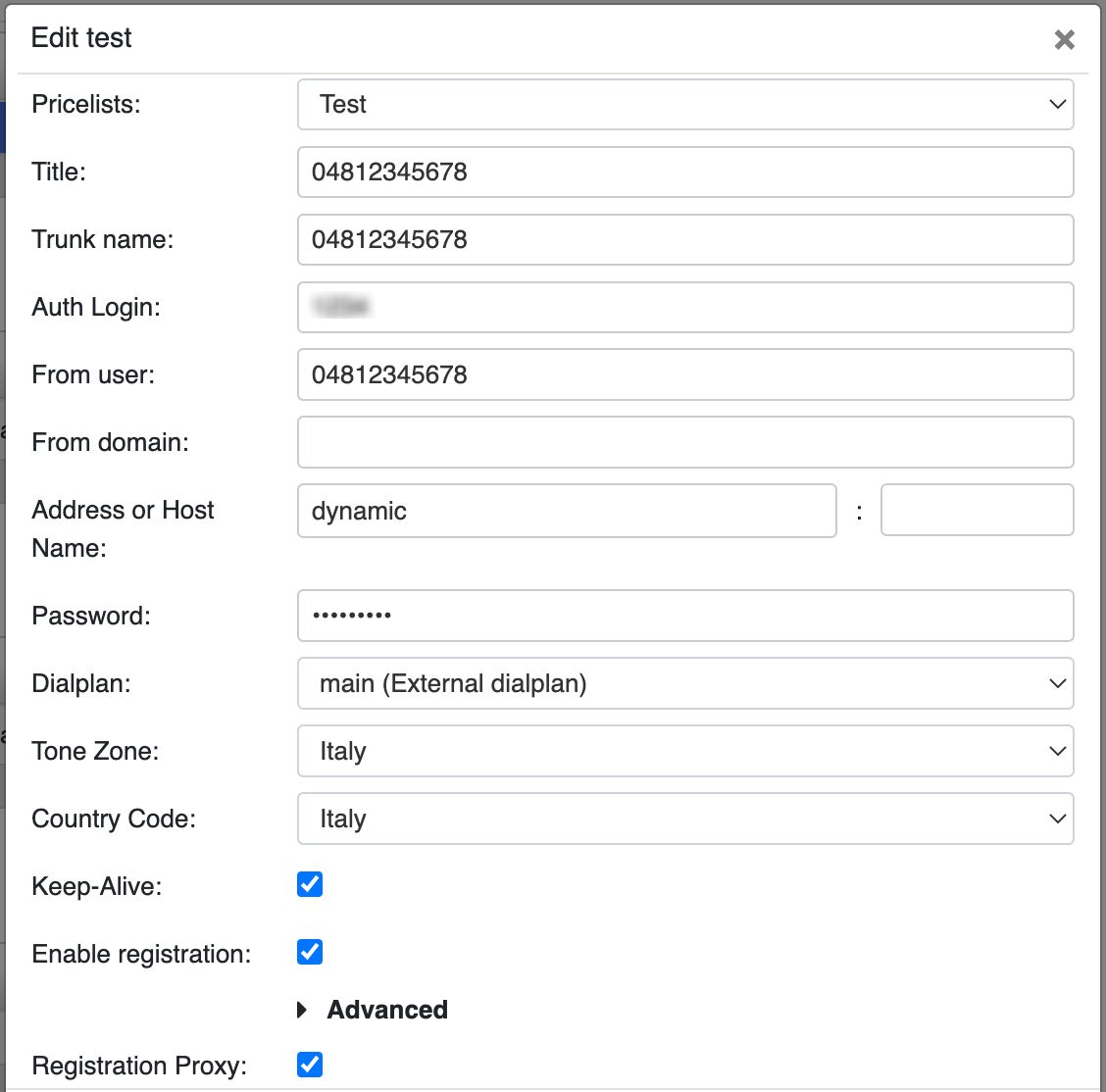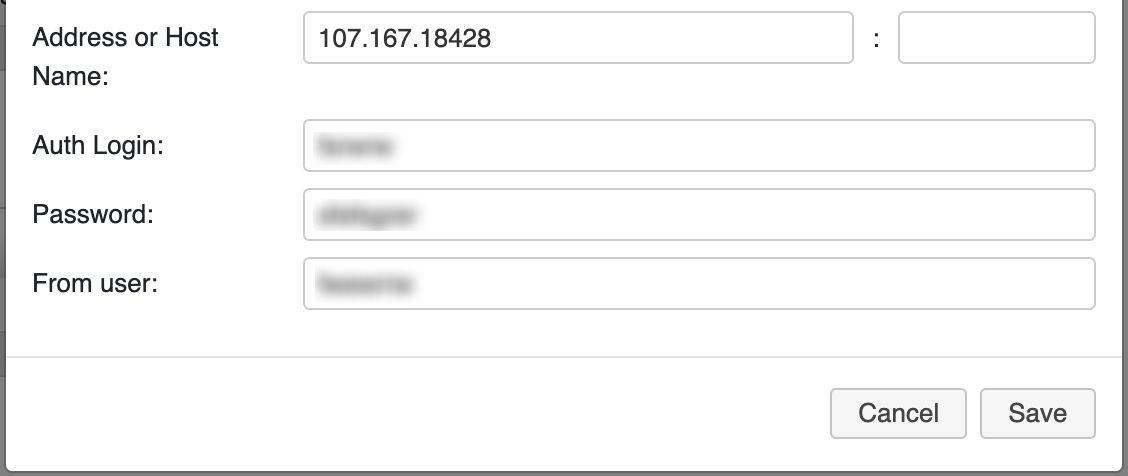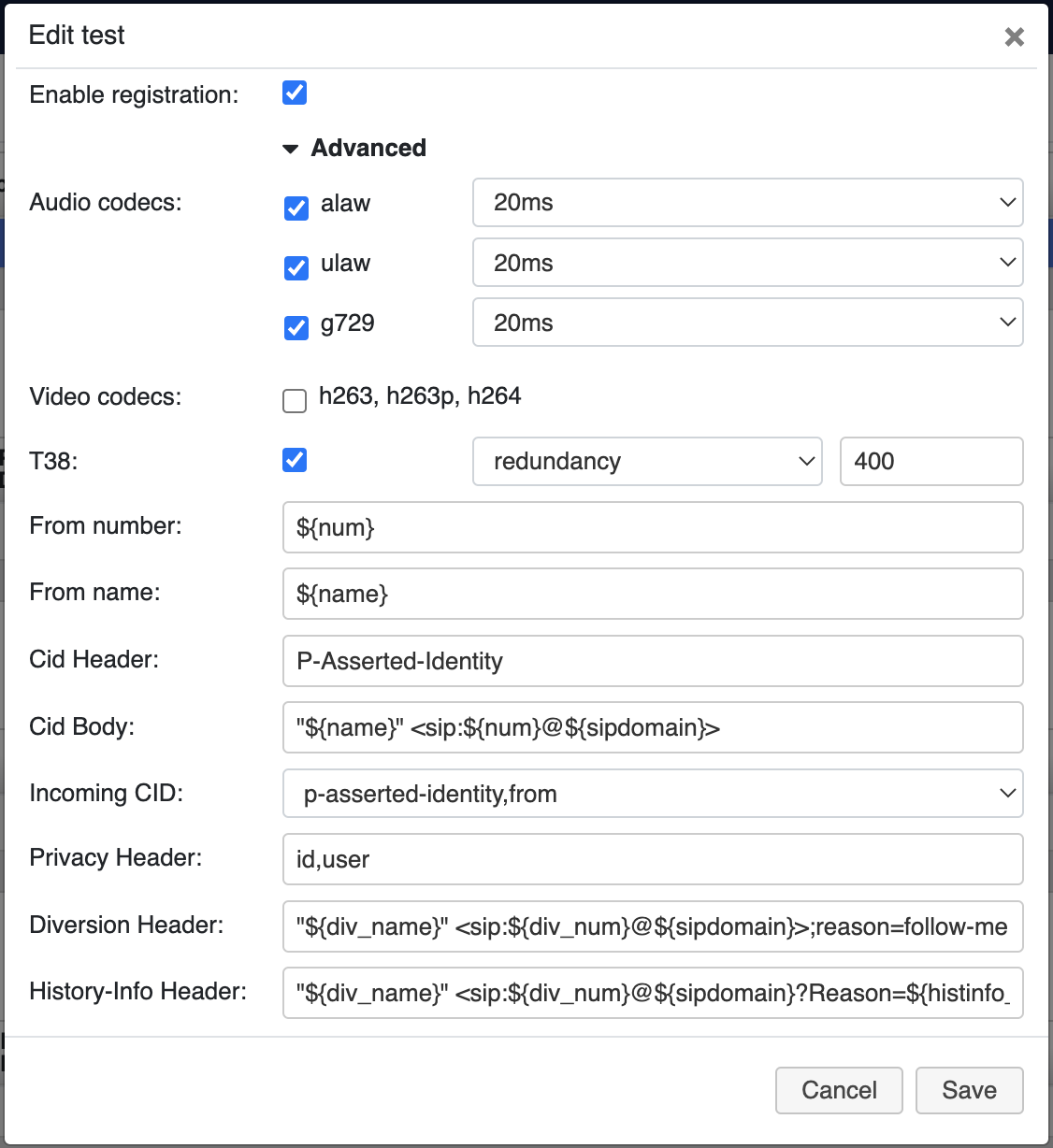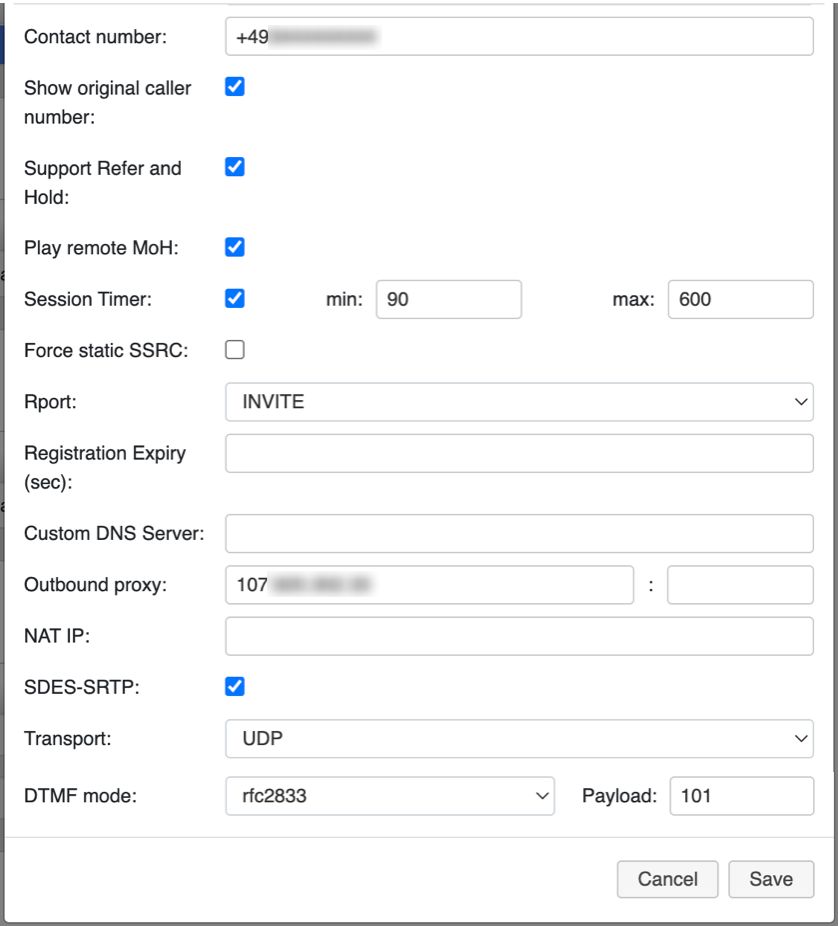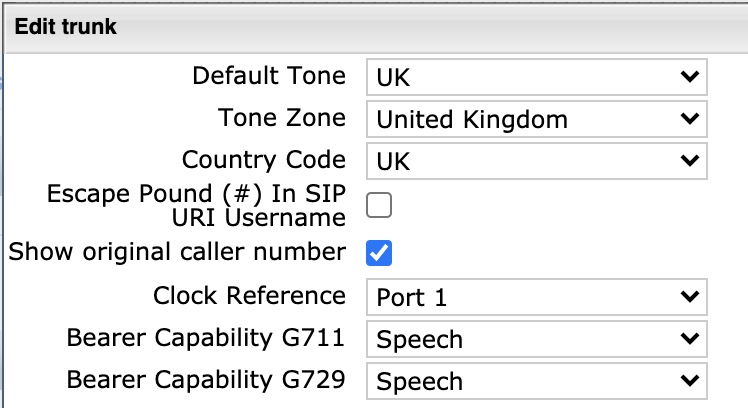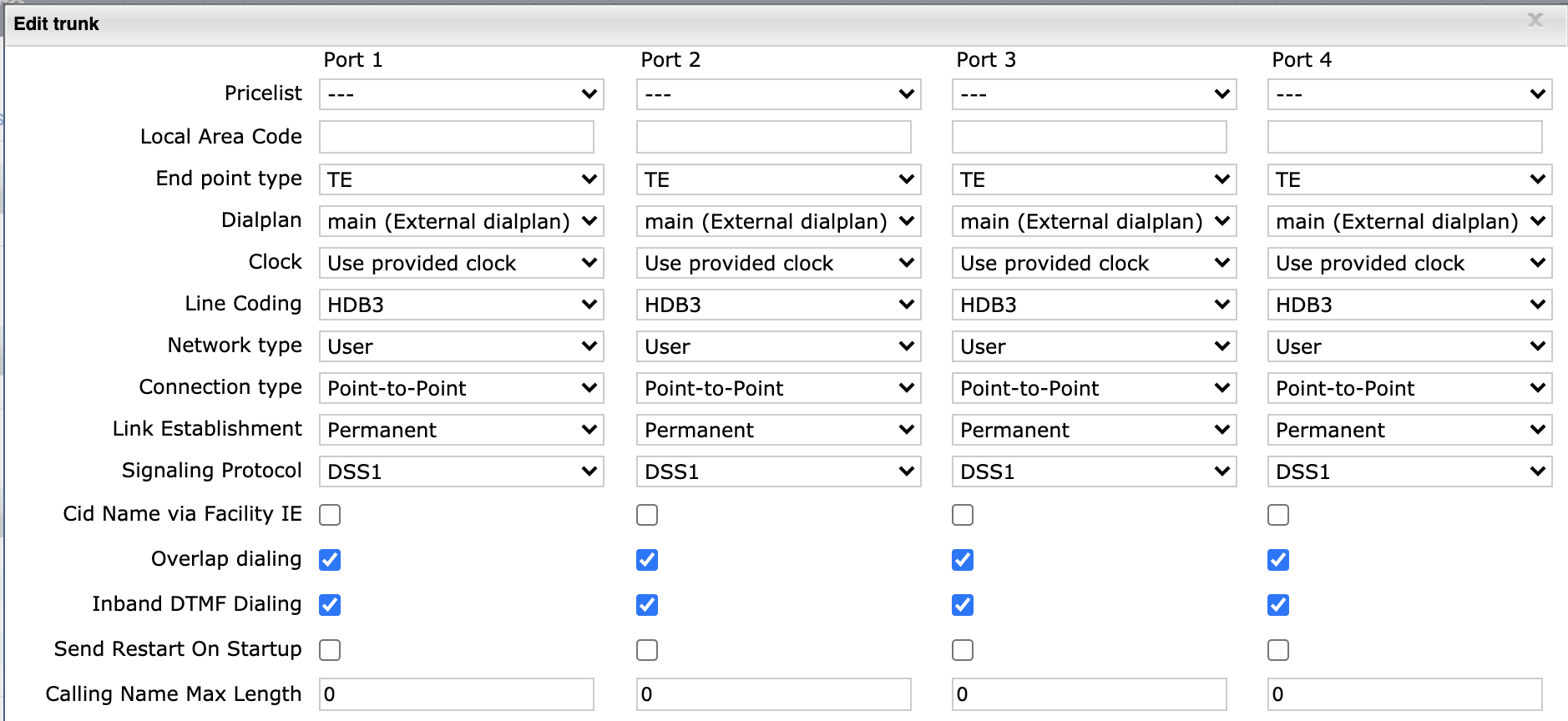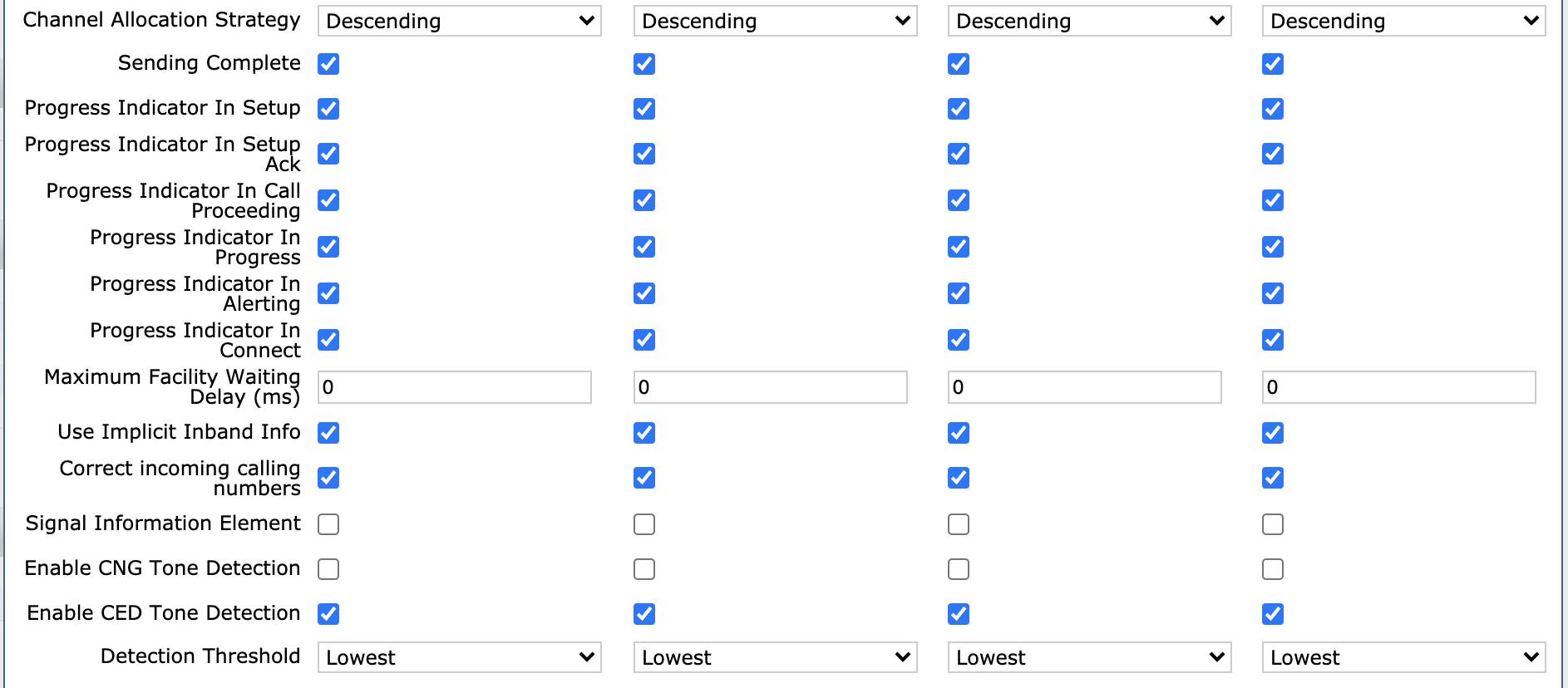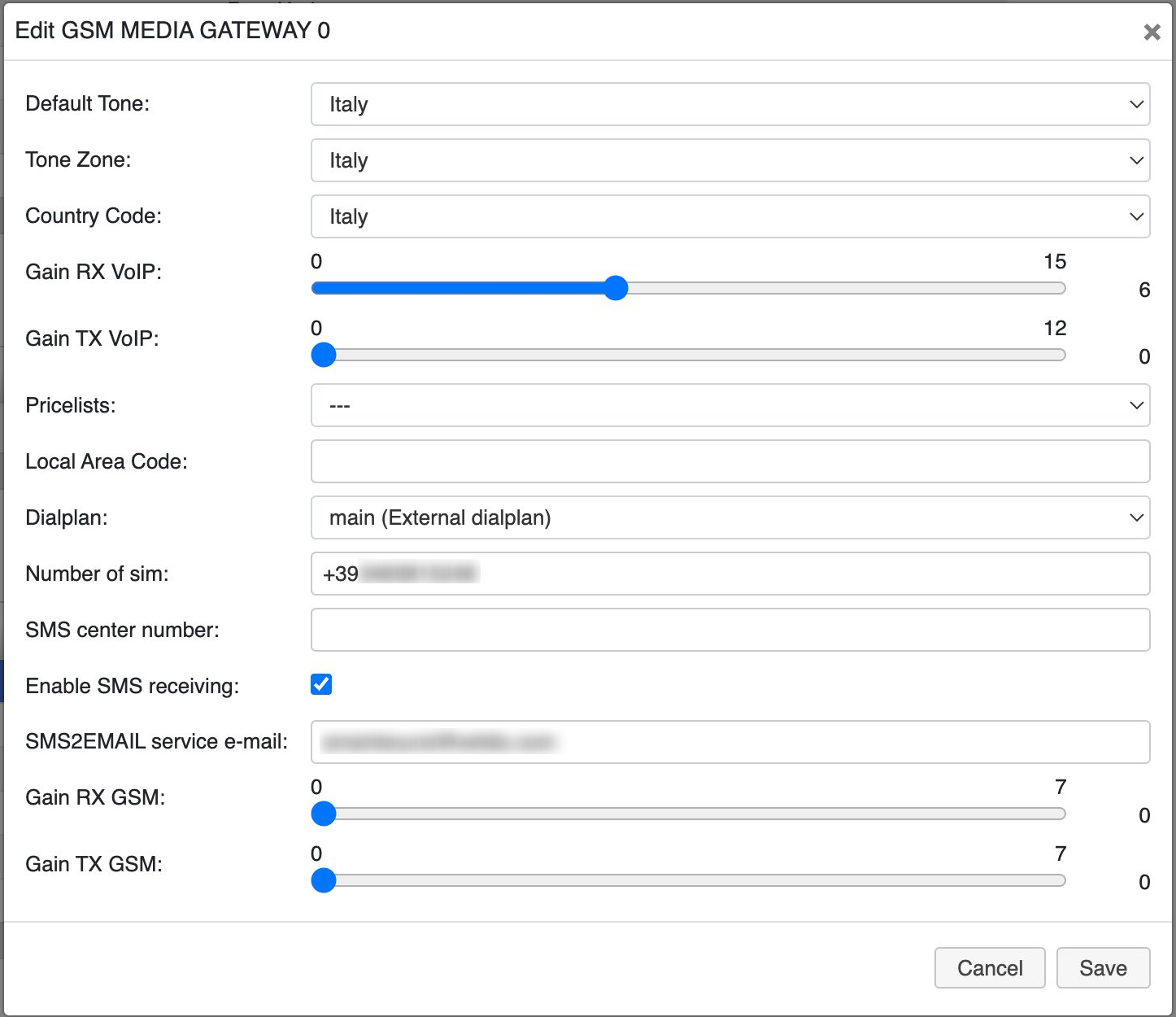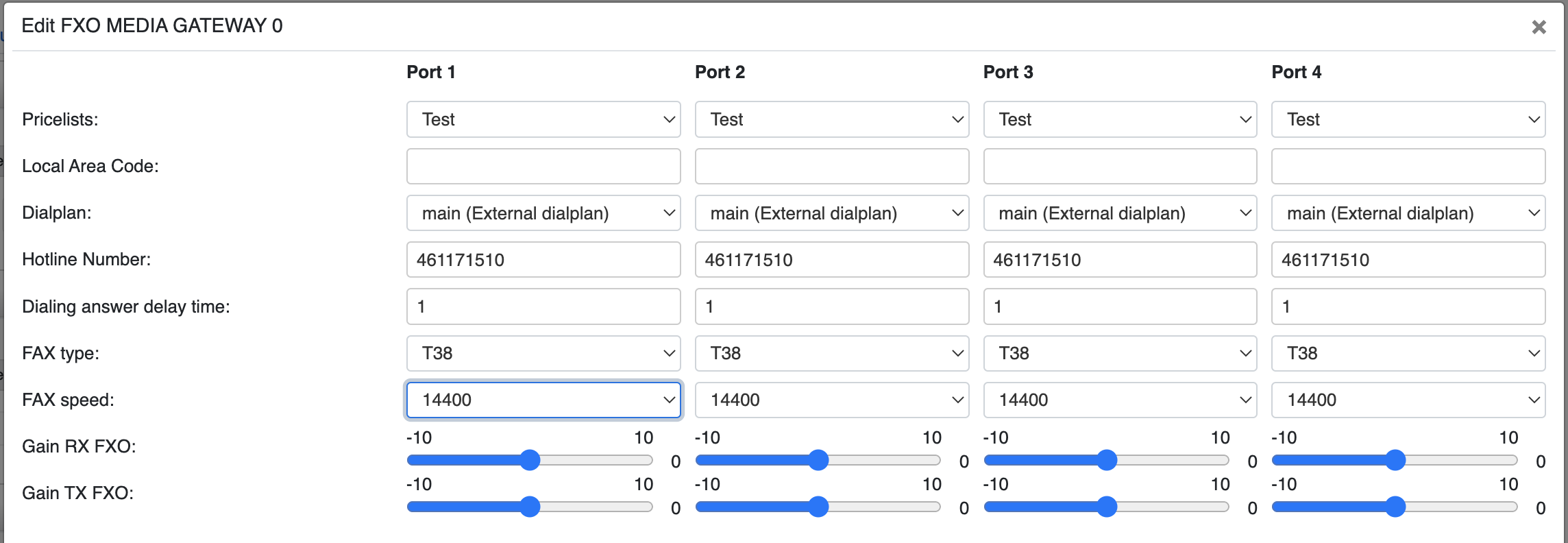ISDN - FXO - GSM - SIP Trunk Settings - Admin Guide
The following Admin Guide describes Trunk Settings and explains how to set up various parameters.
Updated: September 2023
WMS version: WMS 6.0X / WMS 5.0X
Permalink: https://wildix.atlassian.net/wiki/x/tx7OAQ
BRI/ PRI Media Gateways are EOL.
Introduction
Each trunk is displayed in WMS -> Trunks in the corresponding section (SIP, BRI/PRI, GSM/UMTS, FXO) with real time registration status. For GSM gateways the signal power status is also displayed.
SIP trunks must be added manually. To add a SIP trunk, click “+” icon below the SIP trunk table.
GSM, BRI/PRI and FXO trunks appear in the corresponding tables of the Trunks menu after you have provisioned the gateways in the Devices menu of the WMS.
Each trunk is displayed in the corresponding section of the page with the following information:
Country code
SIP registration status (outgoing or incoming, depending on the SIP trunk configuration):
Green: trunk is registered
Grey: trunk is not registered
- For GSM trunk, the GSM signal power status is displayed
For BRI/PRI and GSM trunks, status of Layer 1 and Layer 2 for each port is displayed:
Green: active
Red: error (inactive)
Grey: no event received (inactive)
SIP Trunk Settings
Parameters:
- Pricelist: associated pricelist for the correct calculation of calls cost (must be configured in WMS -> Trunks -> Pricelists)
- Title: description of the trunk
- Trunk name: trunk name
- Auth Login: provided by the VoIP Carrier for authentication
- From user: forced from number header and used for invite messages and for registration (if From domain is not empty), usually the same as Auth login
- From domain: forced from domain header and used in register and invite SIP messages
- Address or Host Name: address or host name of sip proxy; dynamic indicates that the trunk is used for incoming registration (incoming invites are allowed)
- Password: password for authentication provided by the VoIP Carrier
- Dialplan: Dialplan procedure for routing calls coming from this trunk (usually, “main”)
- Tone Zone: select the country/ region
- Country Code: used for number normalization, specify the code of the country where the trunk is used
- Keep-Alive: enable periodic sending of keep alive messages to the trunk
Enable registration: enable outgoing registration (in case of PBXs SIP interconnection, it is enabled on the Client PBX SIP trunk and disabled on Server)
- Registration proxy (appears after checking off Enable registration, optional): enter IP address or host name of a proxy server with the port (the default port is 5060) and credentials for access
- Advanced
Audio codecs: enable the audio codecs supported by the trunk and the ptime values: 20ms – 40ms – 60ms (20ms by default); in case a different priority is needed, use “Set” -> “Codec” Dialplan application
Note: The default codec priority for SIP Trunks starting from WMS 6.02.20230306.1 is the following:
- alaw
- ulaw
- g729
- Video codecs: enable the video codecs supported by the trunk
- T38: special parameters for T38 support and the maxdatagram
- From number: add an expression to set a dynamic cid number for outgoing calls based on the office number or on the value “Set” -> “cid number” on trunk Dialplan application; works only if the operator allows setting of a cid number for outgoing calls
- From name: add a regular expression to set a dynamic cid name for outgoing calls
- Cid Header: add an additional header to set the cid number
- Cid Body: indicate the contents of the cid header
- Incoming CID: setting of a specific SIP header from which Cid header must be retrieved. Available options: p-asserted-identity,from (default) / from
- Privacy Header: setting of the privacy header content supported by the operator to perform anonymous calls via feature code “Hide number” (92 by default)
- Diversion / History-Info Header: add SIP header Diversion and History-info for outgoing INVITE to trunk in order to preserve the information on the original called number in case of call forwarding
- Contact number: allows to set custom contact number in SIP trunk configuration; Note: The field is available starting from WMS v. 6.01.20221019.4
- Show original caller number: can be used by operators which support displaying any number as cid, allows displaying original caller number from trunk in case of transfers/ mobility calls
- Support Refer and Hold: allow the trunk to perform transfers and disable hold requests from the trunk
Play remote MoH: configure remote music on hold to be played instead of the local one for external calls
Limitation: For the Play remote MoH settings to apply, make sure the Support Refer and Hold option is enabled.
- Session Timer: enable the check of the session validity to avoid pending calls; if enabled, the value 360secs is used, if disabled – 7200 secs
- Force static SSRC: forbid SSRC change in RTP sessions; this option is recommended for some SIP operators which do not playback RTP packets after change of SSRC
Rport: the rport mechanism changes the SIP routing behavior, so that responses can be received through a NAT even if private addresses are used in the SIP headers; available options: INVITE (default), REGISTER/INVITE, off
Limitation: If PBX is behind NAT and uses trunk with rport REGISTER, INVITE, the remote side may drop calls after 30 seconds.
- Registration Expiry (sec): set the expiry time for outgoing register messages (default=600 sec / min=0)
- Custom DNS Server: used to resolve the sip proxy domain name
- Outbound proxy: all outgoing SIP messages are sent through the indicated host
- NAT IP: enable the network connection IP
- 100rel: enable reliable transmission of provisional messages
- SDES-SRTP: enable SDES-SRTP protocol for calls through the trunk
- Transport: select the transport protocol to be used: UDP/ TCP/ TLS/ auto (dns ptr-srv)
- DTMF mode: allows you to select the DTMF transfer mode: info/ rfc2833/ inband and specify the payload
Supported VoIP operators and examples of configuration
Check out Wildix supported VoIP providers in the USA, Italy, Germany, France, Switzerland, the Netherlands, Austria, Spain, the UK and examples of configuration on THIS PAGE.
Supported custom config parameters
You can set different custom config parameters for trunks, for example, set Q-Value for trunk registration or enable transcoding for web phone calls to trunks which do not support G711. Refer to Custom config parameters List for details.
BRI/ PRI Trunk Settings
Parameters:
- Default Tone: select the country for the correct tone recognition
- Country Code: used for number normalization (in case “Custom country” is selected, you can manually enter the country code)
- Escape Pound (#) In SIP URI Username: enables support of pound (#) symbol in called number, normally used as a confirmation to send number; as a rule it is used in integrations with legacy PBXs
- Show original caller number: can be used by operators which support displaying any number as cid, allows displaying original caller number from trunk in case of transfers/mobility calls
- Clock Reference: port selection for clock management
- Bearer Capability G711 / G729: used by the calling party to specify the kind of B channel that is being requested. It is indicated in the Q.931 SETUP message and it is used to distinguish among the different types of voice and data calls; in case “unrestricted” is selected, calls might be rejected if no end-to-end digital circuit is available
- Port X. Below you can set up parameters for a single port:
- Pricelist: the pricelist to calculate the costs for calls through the trunk
- Local area code: specify the area code
- End point type: select between TE (Terminal Equipment) (connection to public ISDN) or NT (Network Termination) modes (connection to ISDN phones or other devices in TE mode, e.g. PBXs)
- Dialplan: Dialplan procedure for routing calls coming from this trunk (usually, “main”)
- Clock: select between Generate clock and Use provided clock modes; in ISDN network one endpoint acts as a SERVER, generating the clock signal, and the other endpoints act as CLIENTs, synchronizing on the clock signal received from the SERVER; typically a NT type endpoint acts as clock SERVER, and a TE type endpoint acts as clock CLIENT; set to CLIENT for connection to operators
- Line Coding: select one of the line coding schemes: B8ZS (Bipolar 8-Zero Substitution), HDB3 (High Density Bipolar 3), AMI (Alternate Mark Inversion)
- Network type: select the type of the ISDN network
- Connection type: select the type of ISDN connection between Point-to-Point and Point-to-Multipoint
- Link Establishment: select the connection establishment type between Permanent and On Demand
- Signaling Protocol: select the signaling protocol between asymmetric DSS1 (used for connection to public ISDN) and symmetric QSIG (used for trunking between several PBXs)
- Cid Name via Facility IE: enable the gateway to accept Facility messages and enables calling name delivery for US and Canada
Overlap dialing (enabled by default): enable the gateway to begin processing a call as soon as it can determine a destination from dialed digits that form only part of a complete number; the feature must be enabled for DID (Direct Inward Dialing) management
Important: The option may need to be disabled for some VoIP Carriers for outgoing calls due to the differences in D channel signaling performed for this option.
- Inband DTMF Dialing: enable recognition of inband DTMF tones
- Send Restart On Startup: enable sending of restart request to the operator each time the gateway reboots
- Calling Name Max Length: specify the max length of the calling name
- Channel Allocation Strategy: select the channel allocation strategy for this port
- Sending Complete: include Sending Complete information element into setup message; in this case the remote endpoint does not wait for digits coming in overlap mode
- Progress Indicator: enable the gateway to provide the tone of progress during the indicated operations; normally these parameters are disabled
- Maximum Facility Waiting Delay (ms): maximum waiting time of a Facility request
- Use Implicit Inband Info: enable the use of tones coming from endpoints
Correct incoming calling numbers: used for correct caller number visualization (adds 0 to national and 00 to international calls)
Note: The option is no longer applied for trunks with the USA country code: 0/ 00 are not added to national/ international incoming calls.
- Signal Information Element: enable the use of Signal Information Element field to provide tones during different stages of call processing; this parameter must be enabled in NT mode only
- Enable CNG / CED Tone Detection: allow voice and fax calls on the same line; enable the gateway to detect calling tone (CNG) generated by a fax machine, and called (answering) tone (CED) to enable T38 protocol
Detection Threshold: set up the threshold level for FAX detection
Enbloc signaling for outgoing calls
Some routes are not enabled by the operator to support Enbloc method by default (when number is transmitted in a single message and not digit by digit, which means you first enter the number and then lift up the receiver). In case this method doesn’t work, request your operator to enable enbloc signaling on your router.
Here is an example of Cisco 2811 router (Telecom Italia operator) configuration which enables the enbloc method:
dial-peer voice 102 pots
translation-profile incoming 373123456
answer-address .%373123456T
direct-inward-dial ***added line (riga aggiunta)***
port 0/2/0
GSM Trunk Settings
Parameters:
- Default Tone: select the country/ region
- Tone zone: select the country/ region
- Country Code: used for number normalization. In case “Custom country” is selected, you can manually enter the country code
- Gain RX VoIP: adjust the incoming gain level (VoIP channel)
- Gain TX VoIP: adjust the outgoing gain level (VoIP channel)
- Pricelist: selection of the pricelist for the line
- Local Area Code: specify the area code
- Dialplan: Dialplan procedure for routing calls coming from this trunk (usually, “main”)
- Number of sim: the number corresponding to the line which is present in the associated Dialplan procedure
- SMS center: the option to insert manually the number of the SMS center
- Enable SMS receiving: enable incoming SMS messages to the SIM card (it’s necessary to specify the e-mail address in the field below)
- SMS2EMAIL service e-mail: e-mail address used for new messages notifications
- Gain RX GSM: adjust the incoming gain level (GSM channel)
- Gain TX GSM: adjust the outgoing gain level (GSM channel)
FXO Trunk Settings
Parameters:
- Tone Zone: select the country/ region
- Country Code: used for number normalization. In case “Custom country” is selected, you can manually enter the country code
- Impedance: select one of the impedance values to avoid noise during line connection
- DC Impedance (disabled by default)
- Obtain FSK CID from (available for W04FXO 2020): select the value to display the correct Caller ID. The default value depends on a language selected in WMS Settings -> PBX -> Language&Region:
- for English-US, the default value is Callee
- for other languages, the default value is Nu
- Pricelist: the pricelist to calculate the costs for calls through the trunk
- Local Area Code: specify the area code
- Dialplan: Dialplan procedure for routing calls coming from this trunk (usually, “main”)
- Hotline Number: the number corresponding to the line which is present in the associated Dialplan procedure
- Detect caller ID (available for FXO gateways pre 2020): enable/disable caller ID detection
- Caller ID type (available for FXO gateways pre 2020): select the standard for transmitting the caller ID information
- Flash time (available for FXO gateways pre 2020): timeout (in msec) for hookflash detection
- Dialing answer delay time: interdigit dial timeout (in sec), when terminated, the call is sent to trunk (the value cannot be less than “1”)
- FAX type: select the mode (T38 or Bypass)
- Gain RX FXO: adjust incoming audio gain
- Gain TX FXO: adjust outgoing audio gain
- Disconnect signaling: select one of the options:
- Busy tone (the default value)
- Polarity reversal: enable/ disable this parameter to avoid dropped calls due to a wrong detection of polarity change on the copper line
- Open switching interval: enable/disable the parameter and set the Current Disconnect Threshold in ms
- Polarity reversal on answer: enable/ disable this parameter as the cause for disconnecting the call
- Silence detection: enable/ disable this parameter as the cause for disconnecting the call and specify the timeout in second
These parameters are available for W04FXO R3 starting from WMS 5.03.
FXO gateway can be used to connect an Analog PBX to Wildix VoIP PBX or to enhance some users with Unified Communications features such as fax server, mobility, IVR, timetables etc. Read the White Paper: https://drive.google.com/drive/u/0/folders/10kpqi9yJM6gZ7E_YhkmHX6g0pSOTL0KB
